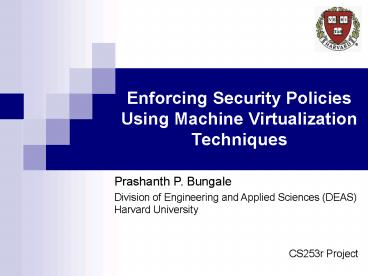Enforcing Security Policies Using Machine Virtualization Techniques - PowerPoint PPT Presentation
1 / 16
Title:
Enforcing Security Policies Using Machine Virtualization Techniques
Description:
BASIC-BLOCK. Optimizations. Ignore the self-transitions. If there are no transitions ... Omit the basic-block itself and directly halt. Performance Evaluation ... – PowerPoint PPT presentation
Number of Views:71
Avg rating:5.0/5.0
Title: Enforcing Security Policies Using Machine Virtualization Techniques
1
Enforcing Security Policies Using Machine
Virtualization Techniques
Prashanth P. Bungale Division of Engineering and
Applied Sciences (DEAS)Harvard
University CS253r Project
2
Reference Monitor
- Observes execution of a target system
- Halts the system whenever upon violation of a
security policy - Must be protected from subversion by target system
3
Security Automaton
- Involves
- A set of states
- An input alphabet
- A transition relation
- Transition relation defines a next state for the
automaton given its current state and an input
symbol - If no transition can be made, then the security
automaton rejects its input - Security automata can be regarded as defining
reference monitors - Input alphabet ? Events seen by reference monitor
- Transition relation encodes a security policy
4
SASI(Erlingsson and Schneider 2)
- A technique that modifies object code for a
target system to include reference monitors that
enforce security policies described by security
automata - Encode the automaton state transitions
immediately before each security-relevant
instruction, halting the code whenever the
security automaton rejects an input - Ultimately, the authors found that
- Even though their mechanism offered high
flexibility - It suffered from extreme performance overheads
because of the enormous amount of extra code
inserted by their mechanism
5
Machine Virtualization Techniques
- Machine-level dynamic binary translation and
protection from subversion by target - Have been used in wide range of applications
- Debugging
- Performance analysis
- Dynamic optimization
- Full machine virtualization
- Program Shepherding
6
Program Shepherding (Kiriansky et al. 2002 3)
- Method for Monitoring control flow transfers
during program execution to enforce security
policies - Three techniques
- Restricts execution privileges on the basis of
code origins - Restricts control transfers based on instruction
class, source, and target - Guarantees that sandboxing checks placed around
any type of program operation will never be
bypassed - Minimal or no performance penalties
7
VDebug(Bungale et al. 2004 1)
- x86 to x86 dynamic translation system
- Designed to achieve least complexity rather than
maximal optimization - Resulting implementation exposes overheads
intrinsic to all binary translation mechanisms - Yields performance comparable to more aggressive
translation strategies that use intermediate code
gen.
8
Our Approach SA-VDebug
- Use machine virtualization techniques to enforce
Schneiders security automata 4 - Batch state transitions into transition summaries
for an entire basic-block (instead of once every
instruction) - Maintain cache of already-computed transition
summaries and re-use them - Use techniques provided by underlying VDebug
system to protect against subversion by target
system
9
Key Advantages
- General framework for extremely flexible
enforcement of security policies - Reuses protection mechanisms already implemented
by underlying virtualization system - While, at the same time, incurring reasonable
performance overhead at run-time - Can easily be enhanced to pin-point the trace
that resulted in a security automaton violation - Provides the security guarantee without making
any assumptions about the target program
10
Key Limitations
- Currently supports only the subset of security
automata not involving input symbols that depend
on state outside the security automaton - Since VDebug is not an optimizing dynamic
translator - Multi-threaded programs not supported yet
- Security automaton not enforced across Interrupts
/ Exceptions / Signals - Only enforced within program execution context
Note None of these are inherent limitations of
our approach
11
Example
PROLOGUE
BASIC-BLOCK
12
Optimizations
- Ignore the self-transitions
- If there are no transitions
- Omit the basic-block prologue
- If it is guaranteed that there cannot be a
transition into the bad state - Omit the bound instruction
- If a transition into the bad state is guaranteed
in all cases - Omit the basic-block itself and directly halt
13
Performance Evaluation
14
Performance Evaluation (contd)
15
Observations
- Translator overhead is negligible Translatee
overhead is the significant factor - Size (i.e., number of states, transitions, etc.)
of the automaton doesn't really matter - But, the number and the (popularity) class of
input symbols does matter - The optimizations that we introduced did matter
16
References
- Prashanth P. Bungale, Swaroop Sridhar and
Jonathan S. Shapiro. Low-Complexity Dynamic
Translation in VDebug, Masters Project Report ,
The Johns Hopkins University, Baltimore, MD
21218, USA, May 2004. - Ulfar Erlingsson and Fred B. Schneider. SASI
Enforcement of Security Policies A
Retrospective, Proceedings of the New Security
Paradigm Workshop, Ontario, Canada, September
1999, pp. 87-95. - Vladimir Kiriansky, Derek Bruening, and Saman
Amarasinghe. Secure Execution via Program
Shepherding, Proceedings of the 11th USENIX
Security Symposium, San Francisco, CA, August
2002.































